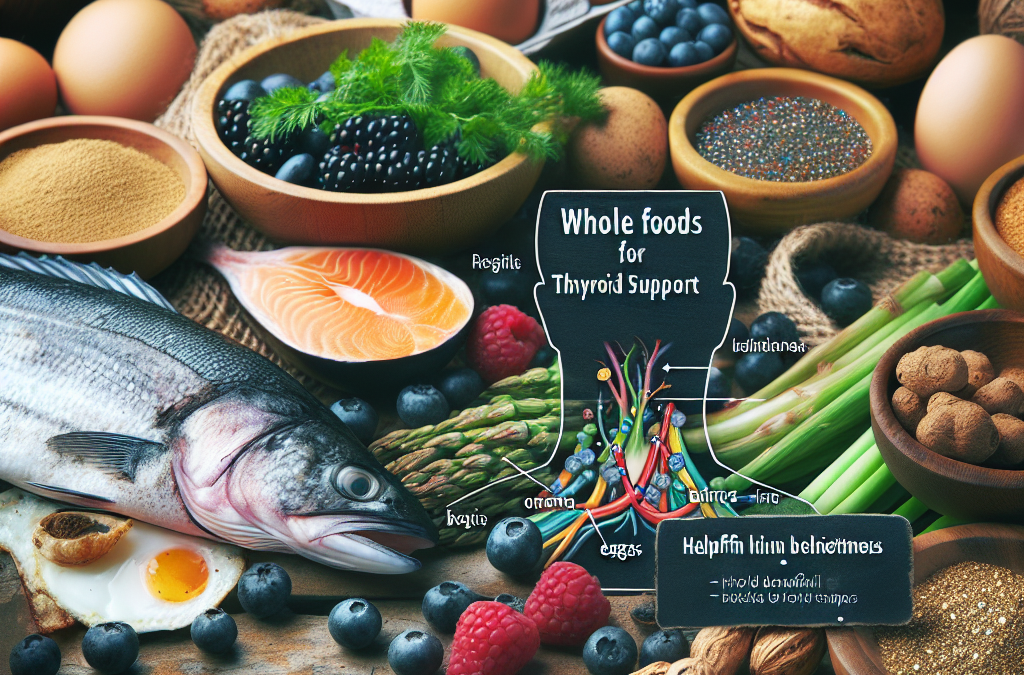1. Cruciferous Vegetables
Understanding the Benefits
Hey there! So let me tell you about cruciferous vegetables, which are a big deal when it comes to thyroid health. Stuff like broccoli, kale, and cabbage are all part of this family. They are packed with nutrients like fiber, vitamins C and K, and antioxidants. But what’s super interesting is that they also contain substances called goitrogens, which can affect thyroid function, especially when eaten raw.
However, don’t freak out just yet! The good news is that when you cook these veggies, especially by steaming or boiling, the goitrogens become less potent. This makes it easier for your thyroid to thrive while still enjoying your favorite green foods. Plus, they are great for your overall health too!
Incorporating these veggies into your diet can be as easy as adding them into stir-fries, salads, or as a side dish. Trust me, they can add so much flavor and crunch to your meals while helping support your thyroid function. So, go ahead and give them a whirl!
Best Preparation Methods
Now, when it comes to preparing cruciferous veggies, I like to keep it simple and tasty. Steaming is my go-to method because it retains most of the nutrients while softening them just enough. Tossing them in a bit of olive oil, salt, and pepper after steaming makes them super delicious.
You can also roast them! Just chop them up, toss with some olive oil and your favorite spices, and bake at about 400°F until they’re golden and crispy. Yum! Roasted kale chips are honestly a game-changer for snacking, too.
Another way to enjoy these veggies is by including them in smoothies. Yep, you heard that right! Just a handful of spinach or kale can sneak into your morning smoothie without dominating the flavor. Layer in a banana, some almond milk, and you’ve got a tasty breakfast that’s also a thyroid-support superstar!
Daily Serving Suggestions
How much should you be eating? Well, I aim for about two to three servings of these bad boys each week. But honestly, it all depends on your own daily habits and preferences. Some people might love them so much they go for more!
Try adding a stir-fried mix of kale and broccoli to your evening meals—or how about a vibrant salad topped with shredded cabbage and carrots? That crunch adds a nice texture and is super refreshing.
Don’t forget versatility! You can throw them into soups, stews, or even omelets. The key is making it fun and finding what works for you. Enjoy experimenting with different combinations and see what you like best!
2. Healthy Fats
The Power of Omega-3s
Healthy fats are another essential component of a thyroid-supportive diet. Now, I’m not talking about greasy fast food, but rather about wholesome fats like those found in avocados, nuts, and seeds. Omega-3 fatty acids, in particular, are fabulous for inflammation control, which can help keep your thyroid happy.
I personally love adding walnuts and flaxseeds to my morning oatmeal or smoothies. They not only add a nutty flavor but also contribute to overall heart health. Plus, they keep me feeling full longer, which is always a bonus.
Fish is another superstar in the healthy fat category, especially fatty fish like salmon and sardines. They’re not only rich in Omega-3s but also delicious! Grilled with a squeeze of lemon? Yes, please! Just be sure to opt for sustainably sourced varieties.
Incorporating Healthy Fats
So how can we easily include these healthy fats in our daily diet? It’s actually pretty simple! Start drizzling some extra virgin olive oil on your salads or using it for cooking. Avocado toast has become my breakfast staple; spread some ripe avocado on whole-grain bread and sprinkle with chia seeds, and you’ve got a nutritious start to your day!
Nuts and seeds are great for snacking. I keep a mix of almonds, walnuts, and pumpkin seeds at my desk for quick bites during breaks. Just a handful keeps energy levels up and cravings at bay.
You can also make delicious dips! For example, blending avocado with Greek yogurt and herbs gives you a creamy dip that works perfectly with crunchy veggies. Snack away guilt-free while boosting thyroid health!
Daily Recommendations
It’s generally suggested that including healthy fats in each of your meals is a smart move. Aim for about one serving per meal to ensure you’re getting enough. Think of it this way: every meal should include some good fat to keep things balanced.
Remember, moderation is key! While healthy fats are beneficial, they’re calorie-dense. Just watch your portion sizes. A couple of tablespoons of olive oil, a quarter of an avocado, or a small handful of nuts should do the trick.
Ultimately, listen to your body. Everyone’s needs can vary, and this is a journey toward discovering what makes YOU feel your best. Enjoy the process and make it tasty!
3. Whole Grains
Nutritional Value of Whole Grains
Whole grains are often underrated in discussions regarding thyroid health, but they are so important! Brown rice, quinoa, barley, and oats pack a serious nutritional punch. They’re loaded with fiber, which not only helps with digestion but also plays a role in hormones balancing, including thyroid hormones.
Your body also loves the sustained energy release that whole grains provide. Unlike refined grains, which can spike your blood sugar and leave you feeling drained, whole grains offer a steadier source of fuel. They help keep those energy levels up throughout the day!
I love starting my day with whole grain oatmeal topped with fruits and nuts. It sets the tone for my meals and really keeps me full until lunchtime! It’s genuinely the breakfast of champions, folks.
How to Include Whole Grains
Getting whole grains into your diet doesn’t have to be complicated. I generally swap out refined grains for whole versions. For instance, when I make pasta, I always choose whole wheat or quinoa pasta. It adds a nutty flavor and makes any dish feel more wholesome!
Another trick is using brown rice in place of white rice or adding barley to soups and stews. Whatever your favorite comfort dish is, you can usually find a way to bulk it up with whole grains.
Get an Amazing Discount on the Best Certified Organic Whole Food Supplement!
Baking? Try substituting half of the white flour in your recipes with whole grain flour. It’s an easy way to increase the nutritional value without sacrificing taste. Trust me, your baked goods will still turn out delicious!
Serving Sizes
As for how much whole grain to aim for, I usually say about three servings a day is a good starting point. A serving could be a slice of whole grain bread, a half-cup of cooked quinoa, or roughly a cup of oatmeal.
It’s all about finding what works for you and your lifestyle! Some might need more, especially if you lead an active life or have different energy requirements. Make it fun and keep experimenting with new recipes!
So, don’t shy away from whole grains! They are versatile and can fit right into your day-to-day meals easily.
4. Lean Proteins
Why Proteins Matter
Lean proteins are essential for maintaining muscle mass and supporting metabolic functions, which includes your thyroid. Think about chicken, turkey, lentils, and beans. I absolutely love incorporating these into my meals because they keep me satisfied and are totally filling!
Protein is critical for fuel, and when it comes to thyroid health, balancing your diet with enough lean protein can help keep your energy levels steady. That’s especially important if you’re feeling sluggish or fatigued. Just a little chicken or tuna salad can do wonders for your energy!
Additionally, proteins help keep your hair and skin healthy—two major concerns if thyroid issues are on your radar. A well-balanced plate is always a good choice for your thyroid and your overall sense of well-being!
Types of Lean Proteins
Now when I talk about lean proteins, there are plenty of choices! For me, cooking lean turkey burger patties is a staple. They cook quickly and can be loaded with fresh vegetables before throwing them on a whole-grain bun.
Fish is also at the top of my list. Salmon, in particular, is not only rich in Omega-3s but also provides quality protein. I often opt for a baked piece of salmon with a squeeze of lemon, served with a side of veggies. Can’t get simpler than that!
Don’t overlook vegetarian options! Legumes like chickpeas, black beans, and lentils are unbelievably versatile. I usually whip up a hearty lentil soup that’s just bursting with flavor. They’re perfect for plant-based protein packed with fiber too!
Building a Balanced Plate
Aiming for a protein source at each meal can really help you stay nourished. Generally, a serving of lean protein is considered to be around three ounces, so keep that in mind as you put together your meals. But don’t stress too much about it; just listen to your body.
Balancing your plate is key! Aim for about one-quarter of your plate filled with lean protein, another quarter with healthy fats, and the rest with those fabulous fruits and veggies!
And let’s not forget—meal prepping can be your best friend! Cooking a batch of chicken or lentils in advance helps take the guesswork out of busy weekdays. Just grab and go for healthy meal options all week long.
5. Nourishing Herbs and Spices
The Power of Gonotropics
We often overlook how much herbs and spices can liven up our dishes and promote health. Certain herbs, such as thyme and rosemary, are particularly beneficial for people looking to support their thyroid function. They’re not just for flavor; they carry medicinal properties too!
I like to sprinkle fresh herbs on my dishes not only for taste but for their antioxidant qualities. Rosemary, in particular, can help modulate inflammation and support a healthy metabolism. Plus, they make every meal look like a gourmet dish!
Another great one is turmeric, which has curcumin in it. This vibrant, yellow spice is famous for its ability to fight inflammation, which can help keep your thyroid functioning smoothly. I love using it in curries or sprinkle it on roasted veggies.
Incorporating Herbs into Your Meals
Adding herbs and spices into your cooking doesn’t take much effort. Dried herbs can be tossed into just about anything, while fresh ones are fantastic as garnishes and flavor enhancers right before serving. I typically make a habit of planting fresh herbs at home. It’s so easy to just snip a few when I’m cooking!
Spice blends can also save you time in the kitchen. A sprinkle of a chili powder mix or herbes de Provence can transform a simple meal. Seriously, it’s like a flavor party in your mouth!
Also, don’t forget about making a detox drink with warm water, lemon, and fresh ginger. It’s a delightful way to start the day while energizing your thyroid—trust me, you’ll feel the difference!
Herb Portion Suggestions
Herbs are generally low-calorie, which means you can use a generous amount! I’m all about liberal use with herbs and spices. Aim for at least an herb portion on each plate—like a tablespoon of chopped fresh herb or a teaspoon of dried herbs in your cooking. Go wild!
Experiment and try to discover which combinations resonate with your taste buds. Everyone’s palate is different, and that’s part of the fun!
Remember, don’t be afraid to play around with flavors; cooking is all about finding joy in the kitchen. Your meals should feel like an adventure, not a chore. Get creative!
FAQs
- What are the best whole foods for thyroid health?
- The best whole foods include cruciferous vegetables, healthy fats, whole grains, lean proteins, and nourishing herbs and spices.
- Can I eat raw cruciferous vegetables?
- While you can eat them raw, cooking them reduces the goitrogens that could interfere with thyroid function. Lightly steaming is often recommended.
- How much protein do I need for thyroid support?
- Aiming for a serving of lean protein at every meal generally ensures you’re getting enough. Typically, a serving is about 3 ounces.
- Is turmeric beneficial for thyroid health?
- Yes, turmeric contains curcumin, known for its anti-inflammatory properties, making it beneficial for supporting thyroid health.
- How can I incorporate healthy fats into my diet?
- You can include healthy fats through avocado, nuts, seeds, and fatty fish, making sure to balance them with your meals appropriately.




